Design of portable meteorological instrument based on MSP430 single chip microcomputer
Portable Meteorological Instrument Based on MSP430F149 MCU
A low-power, compact meteorological instrument has been designed to measure key environmental parameters such as temperature, humidity, air pressure, wind speed, and wind direction. The system is built around the ultra-low-power MSP430F149 microcontroller, which manages data acquisition, processing, and storage. It uses a combination of sensors including temperature, humidity, barometric, wind speed, and wind direction modules. Real-time data is displayed on a 12864 LCD screen, while E2PROM is used for long-term data logging. This device is ideal for small-scale climate monitoring due to its portability, low power consumption, and high accuracy.
0. Introduction
Accurate measurement of meteorological parameters is essential in various fields like agriculture, industry, and navigation. However, traditional weather stations are costly and not suitable for localized measurements. To address this, a portable and energy-efficient meteorological instrument was developed. It offers real-time data display, automatic storage, and query capabilities, making it ideal for small-area monitoring with high reliability and cost-effectiveness.
1. System Design and Working Principle
As shown in Figure 1, the system is centered around the MSP430F149 microcontroller. It integrates temperature, humidity, pressure, wind speed, and wind direction sensors, along with an RTC module, E2PROM, and a 12864 LCD display. Data from the sensors is processed by the microcontroller, time-stamped, and displayed in real time. Users can store or retrieve data using buttons, and the system can automatically log data every hour when in standby mode.
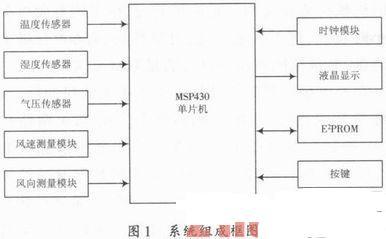
2. Hardware Design
2.1 MSP430 Overview
The MSP430 series from Texas Instruments is known for its ultra-low power consumption, with five power modes and fast wake-up times. It includes features like 12-bit ADC, 16-bit timers, and FLASH memory, making it ideal for battery-powered devices. In this design, the MSP430F149 is used to control the system, reducing peripheral complexity and improving stability. Its low-power mode helps extend battery life.
2.2 Temperature Measurement Module
The AD7416 digital temperature sensor is used for its simplicity and low power consumption. It offers a resolution of 0.25°C over a range of -40°C to 125°C. The I2C interface allows easy integration with the microcontroller. The circuit uses pull-up resistors on SDA and SCL lines, and the address is set to 48H for communication.
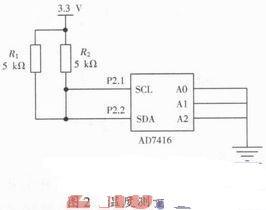
2.3 Humidity Measurement Module
The HS1101 capacitive humidity sensor provides accurate readings between 1% and 100% RH with ±2% accuracy. It uses a 555 oscillator to convert capacitance changes into frequency, which the microcontroller processes to determine humidity levels. The circuit involves R3, R4, and R5 to charge and discharge the sensor, creating a square wave that reflects humidity changes.
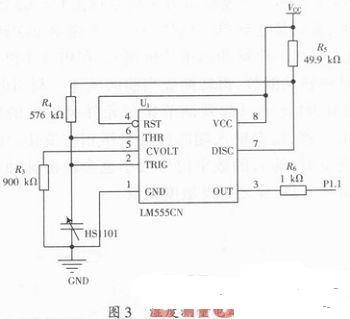
2.4 Air Pressure Measurement Module
The MPX4115 pressure sensor from Motorola provides a linear output proportional to atmospheric pressure. It operates between 15kPa and 115kPa, with an output voltage range of 0.2V to 4.8V. The signal is divided before being sent to the microcontroller’s ADC for conversion into pressure values.
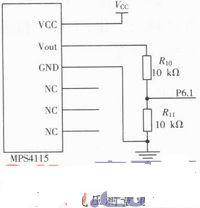
2.5 Wind Speed Measurement Module
The CS3144 Hall effect sensor detects the rotation of a three-cup anemometer with a magnet. Each revolution generates a pulse, which is converted by LM393 and counted by the microcontroller to calculate wind speed. Sensitivity is adjusted via a potentiometer, allowing fine-tuning of the system’s response.
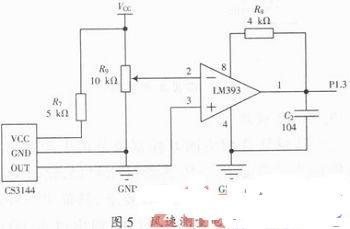
2.6 Wind Direction Measurement Module
The CHA3806 photoelectric encoder measures wind direction by detecting phase differences between A and B signals. When the wind vane rotates, the encoder outputs pulses that indicate direction. The microcontroller interprets these pulses to determine wind direction, displaying it on the LCD with 22.5° increments for clarity.
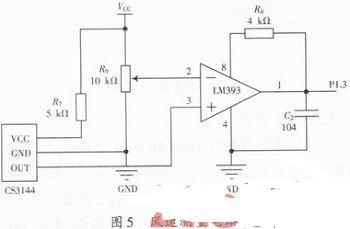
2.7 Human Interface Module
The system includes six independent buttons for functions like observation, storage, and query. The 12864 LCD displays real-time data and supports backlight adjustment for power savings. During automatic mode, the backlight turns off, reducing power consumption while storing data hourly.
2.8 Other Hardware Modules
Power is supplied via a 5V lithium battery, regulated down to 3.3V for the microcontroller. The DS1302 RTC ensures accurate timekeeping with minimal power draw. An AT24C256 E2PROM stores large amounts of data through the I2C bus, ensuring reliable long-term logging.
Redundant Power Supply Series,Full Modular Redundant Power,800W Redundant Power Supplies,Redundant Server Power Supply 2000W
Boluo Xurong Electronics Co., Ltd. , https://www.greenleaf-pc.com